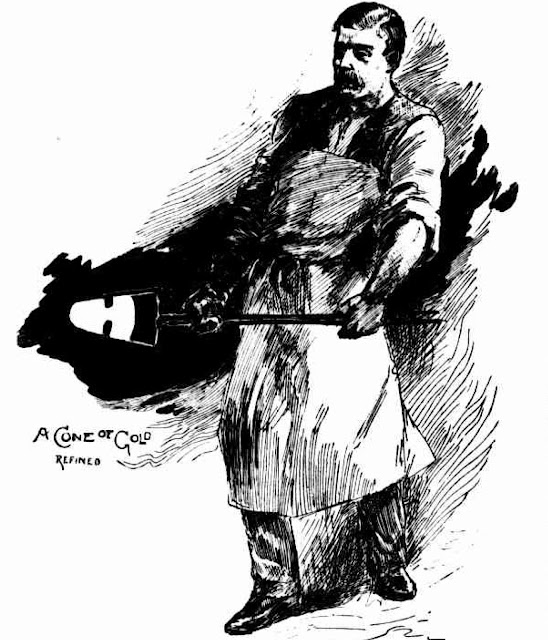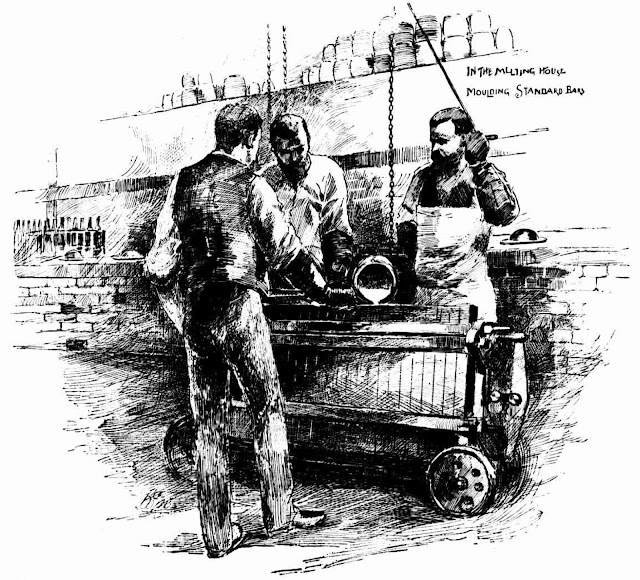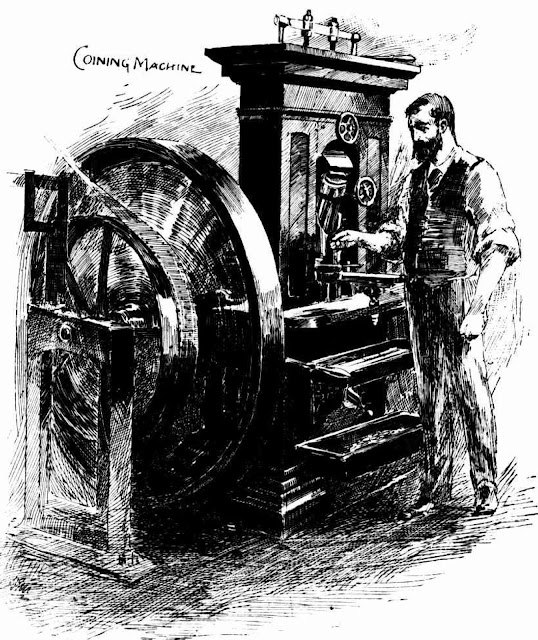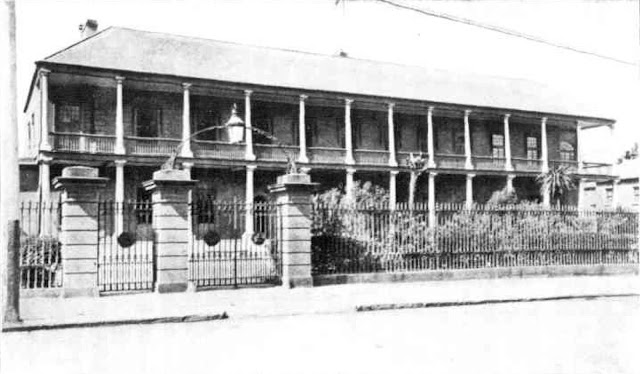In March 1871, the Australian Town and Country Journal published the following article of a tour of the Sydney Mint. The article offers a detailed account of the building and the processes of producing the coinage and gold bars of the day.
IN Macquarie-street are many useful institutions; one public building affords food for the mind, another restoration and renewed vigour to the diseased body. The gates of health and sea breezes open wide to the Domain, and the hospital's broad front expands to receive the maimed, enfeebled, diseased, and afflicted. Hard by stands another imposing structure sacred to personality and the rudiments of the English language; but perhaps the most useful and practical institution among them is the Mint.
The original building in which this national business is now carried on, was built about the time of the battle of Waterloo, and occupied as a military barracks, but subsequently as a convict hospital. In 1856, however, the building was converted to its present use, and the more effectually to carry out its useful purpose, considerable additions have been made under the superintendence of the Colonial Architect.
The first edifice presents a facade in two storeys to Macquarie-street, each storey being shaded by a colonnade of eighteen columns in the early colonial classic style of architecture, advancing ten feet from the face of the wall, reached by two flights of stone steps, and returned at the angles.
The main building is 120 feet long and twenty-eight feet deep, with an extension of ten feet at the back, which did correspond with the balcony and colonnade in front; but the work becoming decayed, brick in cement walls were substituted for the columns, and a considerable increase of room gained.
Immediately on the right after entering is the bullion office divided into four-the receiving office, two clerks' offices, and the strong room. Beyond the bullion office are the accountant's quarters and master's apartment, while at the back, and in what was once the inner colonnade, is the weigher and balance mechanician's office. On the left hand are the messenger's and the waiting rooms, with accountant's offices and store-room above.
The new buildings in which the material work of the establishment is carried on, are in ashlar masonry of one storey only, roofed with slate, louvred and lighted in the roof, with also plenty of windows looking into the court enclosed by their erection in the form of an oblong square. On entering this square from the front the line of buildings forming the opposite side is the coining department. The left side is occupied by the melting-room, and the right side by the workshops. Behind the coining department are the large water tanks, and in the extreme rear, standing detached are the assay offices.
The guard-room and police quarters flank the entrance gates from Macquarie-street, from which the site is separated by a lofty open palisade in iron, of London manufacture, the design of which exhibits a capital combination of simplicity and effect. The bosses on the gates exhibit the royal crown with this inscription in the belt: "Sydney Mint, Australia, 1855."
In the bullion office the balances are well worthy of note. The larger one is constructed to weigh up to 700oz without, or 1000oz with injury to the delicate machinery, but the smaller balance is a new and far more beautiful instrument, by Aertline and Ladd, of London. This is gun metal throughout, with fine knife balances for fixing the beam in position during the weighting of the scales; a hand lever then turns a pair of cams on a shaft below the scales, thus opening a pair of legs which release the knives from the planes at the extremities of the balance, and the beam is free to obey the scales. The delicacy of the instrument is such that the 1000th fraction of an ounce diverts the indicator, and should the balance at any time be out of equilibrium a brass ball unequally weighted stands over the apex of the balance, to be turned by hand in any such direction as shall rectify the inequality.
The strong-room is guarded by a handsome door in iron, locked by two keys, and a master key (Hobbs's patent). Internally the room is 17 feet by 7 feet, having massive walls and covered ceiling, and lined throughout with boiler plate rivetted, and put together on the spot. The exhibits in this dark sanctum are very attractive ingots and wedges of gold weighing 150oz and 250oz each, being ranged on the shelves to the value of L25,000.
The office of the weigher and mechanician contains spare and disabled weights and balances for future use or repair; an oven for japanning, heated by Bunsen's burner, and materials and implements appropriate for the trade.
The melting-room, the end of which forms a small wing at the north end of the old building, facing Macquarie-street, is seventy-five feet long, and has seven ordinary furnaces and six for refining. Coke is the fuel, and nitre and borax are the flux used in melting the gold and getting rid of the dross. The plumbago pots in use are reckoned to stand fifteen operations, and the molten metal is run into moulds of various sizes, each ingot or importation being assayed and paid for accordingly.
The refining process is much facilitated by employing Miller's process of sublimation and of toughening by chlorine gas. There are five generators in earthen ware, holding ten to fifteen gallons each, having three necks, and standing half way up in galvanized iron baths, the generators surrounded by water, and heated with gas beneath; manganese is supplied at one neck, and muriatic acid at the other, from the union of which chlorine gas is generated, and passed out of the third neck, and up a glass tube to glass receivers ranged in a row above, and corresponding to the generators below. From these generators a lead pipe conducts the chlorine gas to the six furnaces — a vulcanized india-rubber branch bringing it down to each furnace, all joints being secured by a cement of india-rubber in chloroform, while compression clamps on the tubing regulate the supply of gas and enables the operator to shut it off when the refining is over. The chlorine thus shut off accumulates in the generator, forcing the acid up the glass tube into the glass receiver above, and the acid no longer acting on the manganese, the generation of gas ceases. The pots in those furnaces are in Frenchy clay, and the whole enclosed in black load crucibles, the covering of the furnace being two fire tiles bound in iron, one of which has a slot for the insertion of a clay tube, or ordinary pipe stem, to pass the jet of gas through the molten metal to the bottom. Now chlorine having a natural affinity for most of the inferior metals has also a special affection for silver, uniting promptly with all the silver present, and forming a chloride. This being very liquid would penetrate the pores of the pot, and to prevent this it is saturated in a boiling solution of borax, and dried. As the chloride is also volatile, its sublimation is checked by melted borax, which forms a film over the fiery metal and keeps down the silver fumes.
Two of the generators above described (and which have beds of quartz pebbles within) have refined 2000 ounces of gold containing ten degrees of silver between 9 a.m. and 2 p.m., from 600 to 700 ounces being operated on at a time, each operation occupying about an hour and a half at the end of which the pots are removed, the gold sets below, the silver is poured off into moulds, the pot is inverted on an iron table, and the bright lump of gold falls out in the shape of a cone, which is scraped and dropped into a solution of chloride of sodium to free it from any remnants of silver.
 |
| A Cone of Gold Refined |
An alloy containing eighty-nine per cent of gold ten of silver and one of baser metal will yield 16 per cent silver chloride cake, which is considered to retain yet twenty per cent of gold and is further treated to a remelting in a boraxed pot with the addition of ton per cent metallic silver. Chloride of gold ensues at the expense of the silver, the gold becoming a button at the bottom of the pot. The gold that remains is now but two grains to every pound troy of silver.
The slabs of silver chloride are reduced by one of Dr. Leibius's ingenious batteries, which is merely a box 13 inches by 14 inches by 15 inches, without top or bottom, having seven silver loops in which to suspend seven half-inch zinc plates, the silver connection being sustained by continuous strips of silver. A stout inner ease, with two handles of iron and six loops of silver to hold six slabs or cakes of chloride, is fitted into the box when the battery is charged by joining the silver bands and the whole immersed in water. In twenty-four hours galvanic action ceases, and the six cakes of chloride though retaining their appearance and shape, are reduced to metallic silver.
But the cone of fine gold has to be remelted, alloyed, moulded, stamped, clipped, rolled, cut, pressed, annealed, dragged, weighed, coined, sulphured, scrubbed, journeyed, sorted, reduced, enlarged, and stamped before it is ready for circulation.
The first process, then, for gold intended for circulation is to remelt, thoroughly mix, and assay; then melt again with a due alloy of copper, when it is run into bars two feet two inches long in a travelling mould carriage containing twenty-four moulds. Each furnace pot on the average will run eight bars of two feet two inches each, the first and last of which are clipped by the bullion-master to test their standard value, and stamped with the number of the pot and bar. The two feet two inch bars are then transferred to the rolling room, containing four mills, through each of which the bar is passed four times to reduce it to the standard thickness. Four passages of the bar, through the first pair of rollers elongates them from two feet two inches to six feet six inches, when they become too hot to hold and are cut into short lengths of thirteen inches each by shears worked by an eccontric off the driving shaft. Thence the bars pass to three other pairs of rollers, being rapidly inserted on one side through a guide-shoot, and are received on the opposite side and repassed to the front by a copper shoot. These mills are driven by three sets of triple cog-wheels off another shaft by bevelled gear from the engines the rollers being set in heavy cheeks having vertical screws adjusted by horizontal toothed circles worked by double-handled worm screws. After the first squeeze the bars are referred to a pair of annealing furnaces, where they are inserted in a wrought iron circular case with lid (not unlike a map-case), and baked red hot to toughen them, after which they pass through the second mill. In the last two pair of rollers the pressure comes from below instead of above, all the rollers being of cast iron chilled. The floor is of waved iron in plates, having wells at intervals to receive the sweepings of the room, which wells are cleaned once a quarter; and near the mills stand a travelling-crane for the moving of heavy machinery.
 |
| In the Melting House Moulding Standard Bars |
Next comes a very ingenious tapering machine, for thinning or tapering the ends of fillets, as the bars are now termed. This is done by steel reverse rollers driven from an auxiliary shaft by a belt which turns double pinion and reverse driving wheels. By a flattened face on the steel rollers the fillet ends are inserted, and by a strop at the back they are checked and returned after entering a certain distance.
Then we have the drag-bench and its powerful dog of steel, with hardened mouth, for dragging the fillets through between steel rollers for final pressure, and having also capstans with horizontal double brass circles, with a pointer to each. An endless chain belt with brass links and iron pins, revolves beneath the tramway on which the dog travels.
There are two cutting-out machines, single and double — the latter of which, by J.Taylor, of Birmingham, having two punches, will turn out 280 blank sovereigns a minute; the other or single one, forty. The double one works by a belt from an auxiliary shaft. The entering fillet is punched in a double row of alternate circles, the circles becoming blank sovereigns which drop into a basket below. There are two pairs of rollers with ratchet wheel and eccentric, the rollers being roughened with a file or the fillets would slip. The fillet, riddled with holes, now takes the name of scissel, which together with notched coin and fillet ends, is returned to be remelted. For this purpose a separate assorting table with treadle for binding scissel in bundles of 150oz each, and for assorting coin, stands near. Such care is taken that the towels used in cleaning gold are dipped in water to save the fine gold.
Between the rolling and coining room stands the superintendent's office, where the blank sovereigns are weighed in journeys of 500, and sent out to be treated to a sulphur bath, and polished on a tray of coarse sawdust to destroy the tarnish of oxidation, and impart brilliancy. After a second weighing they move to the automaton room, to undergo a sorting process, which it is well worth while to watch.
These beautiful machines, almost equal in delicacy to dock machinery, are four in number, in brass, and all driven from a shaft overhead by catgut belts. In each case the belt drives three wheels; the back wheel regulating the feeder, and the front wheels by an eccentrie, controlling the indicator, which, by three notches opposite its foot, graduated in the form of a wedge, and thereby directing the foot of the shoot over the three apertures sorts the descending coin into standard, light, and heavy coin, by dropping it into one or other of three slits just large enough to admit it, which three slits of course communicate with three receptacles below. Long rows of sovereigns fill the scoop or feeder, inclined at a gentle angle above the machine, and with solemn precision each foremost sovereign drops on to the pivot, is weighed and dismissed oft the pivot and down the shoot, to descend to its allotted place, having been weighed and found wanting, or standard, or too heavy, with an unerring judgement. The balance, works on knife edges and has a glass disc with platinum wire suspended in a stirrup for standard weight. A light weight does not balance the disc, and therefore shows light or high, affecting the shoot accordingly, while a heavy coin shows low, moving the shoot in the opposite direction.
These self-acting workers are the invention of an officer of the Bank of England, Mr. Cotton, and are a vast improvement on the old system of weighing by hand each separate coin.
From the automaton room the coin passes to the marking machine, to edge and gauge it fit for milling before annealing.
There are three coining presses, by J. Taylor of Birmingham, one driven direct from the mill shaft and two from a shaft at right angles by bevelled gear from the other. These are worked by a fast and loose belt, working off a crank shaft by a lever to a knuckle-joint moving the top die, the bottom one being a fixture.
 |
| Coining Machine |
The feeder, working to and fro by a cam, supplies coin to the dies, which, as soon as coined, is thrust off the die down a shoot by the feeder, which by the same stroke places a fresh blank for the reception of Her Majesty's image and superscription. The pressure brought to bear in order to effect this stamping process is equivalent to three tons. All coin is weighed in journeys of 500 each at the end of the day, and defective coin is out up at once by hand machinery. This division of the wing is also partially floored with waved iron, the roof being in light iron, with roof lights fended by iron wire; but all wall lights look into the inner square. In this division is also the medal press, worked by a double screw lever of great power, and capable of turning out medals as large as plates.
The wing which corresponds to the melting-room and completes the square, is occupied by engineers', smiths', and carpenters' shops, where repairs are done, mostly by the men employed on the premises. Lathes, planing machines, drilling machines, and forges, are here in good order and condition for the restoration of any machinery out of repair.
The seat of motive power is a beam engine of fifteen horse-power, capable of working up to thirty, having two Cornish boilers twenty-four feet long by seven feet in diameter and a seven feet six inch flue; also steam chest, safety valve, and steam whistle in case of neglect. A spare engine of similar power stands by to assume work in case of any accident occurring to the other-one large steam pipe with stop cock supplying the two. A 20,000 gallon cast iron tank stands over the boiler-house. The diameter of the fly wheel is fifteen feet.
The crushing machinery for the purpose of reducing the minerals sent to the Mint for analysis from all parts of the country, consists of a four-stamp battery, with wire guards 120 to the inch, discharging all round. The tables are short, discharging to two Chilian Mills; thence to a cradle worked by a crank on the Chilian mill shaft, thence through a cast iron amalgamator holding one-half inch of mercury, and finally by a shoot to a catch pit outside, where the tailings are subjected to further analysis if required, or otherwise assist in forming a gravel walk. Two large tanks in the rear receive the condensed water from the engine.
Another highly interesting department of this national institution is the assay offices — two in number — the one under the direction of Mr. M'Cutcheon, and the other of Professor Leibias.
Two pairs of scales under glass stand here for the accurate determination of the sample to be assayed, the standard weight being half a gramme. On another table rows of the neatest little cups, such as would raise a storm in the nursery, are being manufactured out of bone ash imported from Paris, by a simple process of stamping rapidly performed. The half gramme of gold associated with a flux of lead and silver, is put into one of the little bone-ash cups and cupelled. These French cupels contain intense heat, and during the process the useful lead retires into the recesses of the little cup, taking away with it all inferior metals; the little silver-gold button remaining is then rolled out very thin, twisted round a platinum peg on a gold frame, and submitted to three processes of reduction by nitric acid in a glass beaker boiling over one of the Bunsen's burners, the last solution being very powerful. The sample is now termed cornet; soft and brittle, not unlike chocolate until annealed, after which it resumes the gold colour, and is capable of handling the weight determining the assay. The alloy is copper, and the standard eleven per cent, of copper, to two of alloy to twenty-two of gold, termed twenty-two carats fine."
The whole process is very instructive to watch. The cardinal number is five and the bone-ash cups are arranged in fives, or a multiple thereof. In the trays that bear them the divisions are in fives; in the cupel the roast in fives: the platinum pegs on the gold tray bristle in fives, and every individual sample under assay answers to its number as one of five.
The bone-ash cups will absorb three times their weight of litharge, and the alloy of silver and gold is as three to one. In the first boiling in nitric acid the action is very strong, the silver uniting with the acid in a violent manner. When the violence is pretty well over the nitrate of silver is poured off like new milk, and the gold frame of platinum pegs transferred to another beaker containing stronger acid, where the action is much more subdued. The nitric acid used in the stronger solutions is used a second time for the weaker. This is Mr. Millers process of assay. The copper assay by Parkes's process, is founded upon the discolouration of the ammonical solution of copper by cyanide of potassium.
The coinage performed here to December 31st 1870, has been 23,917,500 sovereigns, 1,629,500 half sovereigns. The amount of bar sold cast for exponatation has been valued at LL 710,842 7s 3d. The revenue received and paid into the Treasury has been L308,776 0s 2d.
The employed number thirty-four, and the official staff with their order of appointments are as follows: Deputy master, Charles Elouis, appointed July 22nd, 1868, by her Majesty, by warrant under the royal signet and sign manual. Superintendent of Coining Department, Joseph Trickett, 22nd June, 1853, by warrant from Lords of the Treasury. Registrar and Accountant, William F. Gibson (with quarters) 28th March, 1863, by warrant from Lords of the Treasury. Senior Clerk and Melter, E. O. Heywood, October 1st, 1S70, by warrant from Lords of the Treasury. Assayers — Adolph Leibius, 31st March, 1859; J. M. M'Cutcheon, 1st October, 1870. Clerks — Hugh Gilchrist, 1st January, 1867; L. B. Carpenter, 1st January, 1859; J. F. Adams, 1st July, 1861; J. A. M'Farlane, 1st January, 1867; A. Gardner. Weigher and Balance Mechanician, C. Bolton, 1st January, 1867. Foreman of Machinery and Engineer, J. Newton, 14th May, 1855. Foreman of Melting House, R. Whiting. Foreman of Coining Department, H. Bradstock, 22nd November, 1853, by Deputy Master of the Mint, on approval of the Governor.
The police force on guard and resident on the spot, consists of a sergeant and four men.
The warrant constituting the Sydney Mint issued from a cabinet Council hold at Osborne House, Isle of Wight, on the 19th August, 1853, at which there were present her Majesty and Prince Albert, the Lord President, the Lord Privy Seal, Dukes of Newcastle and Wellington, Lord Chamberlain, Marquis of Lansdowne, Earl of Aberdeen, and Sir James Graham.
At this Council was determined the order of appointment of the officers with their duties, — the chief officer being appointed by her Majesty, and the four principal officers under him by the Lords of the Treasury; the remainder being appointed and discharged by the Deputy Master, on the approval of the Governor.
Sources:
- Mint & Observatory. (1907, May 1). The Sydney Mail and New South Wales Advertiser (NSW : 1871 - 1912), p. 1122.
- The Mint. (1871, March 18). Australian Town and Country Journal (Sydney, NSW : 1870 - 1907), p. 18.
- The Sydney Mint. (1889, October 31). Illustrated Sydney News (NSW : 1881 - 1894), p. 13.








No comments